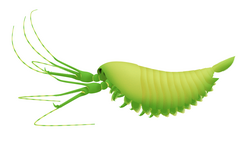| Yawunik Temporal range: | |
|---|---|
 | |
| Fossil paratype | |
 | |
| Life reconstruction | |
| Scientific classification | |
| Domain: | Eukaryota |
| Kingdom: | Animalia |
| Phylum: | Arthropoda |
| Class: | † Megacheira |
| Order: | † Leanchoilida |
| Family: | † Leanchoiliidae |
| Genus: | † Yawunik Aria et al., 2015 [1] |
| Type species | |
| †Yawunik kootenayi Aria et al., 2015 [1] | |
Yawunik is an extinct genus of Cambrian megacheiran ("Great appendage" arthropod) known from the Burgess Shale in Canada ( Marble Canyon locality). [1] The type species has been named Yawunik kootenayi after the Kootenay, both a geographic area (and National Park, where the fossil was found) and North American First Nation, also known as the Ktunaxa. The genus name is derived from Yawuʔnik̓, the name of a primordial sea monster in Ktunaxa mythology. [2] The fossil dates back to 508 million years ago. [3]

